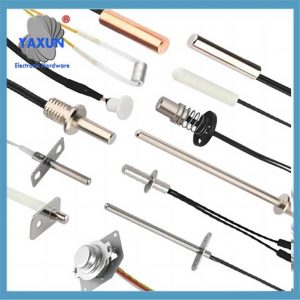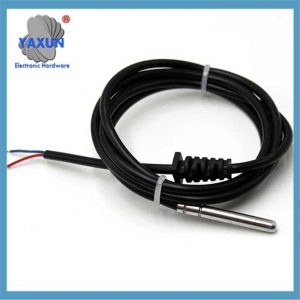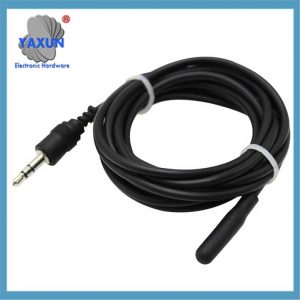NTC (負溫度係數) 溫度傳感器是一種溫度測量元件,隨著溫度升高,熱敏電阻的電阻的指數降低. 它的核心是由燒結金屬氧化物製成的陶瓷半導體 (例如錳, 鈷, 和鎳), 並且通過測量電阻變化來推斷溫度. 以下是其核心技術特徵, 應用, 和選擇點:
我. 核心特徵
工作原理
溫度升高時, 半導體材料的載體濃度和電阻值降低 (負溫度係數特性).
電阻 - 溫度關係符合steinhart方程: r =, B值 (物質常數) 確定靈敏度.
它是如何運作的:
NTC熱敏電阻使用負溫度係數原理, 材料的電阻隨溫度升高而降低. 這種關係通常是非線性的.
KEY參數
標誌性 (R25): 25°C的參考電阻 (例如5kΩ, 10千歐姆, 100千歐姆).
B值: 反映溫度靈敏度 (常見的3435k, 3950K, ETC。), 價值越高, 靈敏度越強.
熱時間常數: 響應速度指示器 (毫秒到幾秒鐘).
準確性: 工業級可以達到-20°C 〜85°C的範圍±0.1°C。.
結構特徵
它由NTC芯片組成, 保護性殼 (金屬/塑料), 導線和終端, 並採用雙層封裝過程,以改善密封和抵抗機械損壞.
柔性尺寸 (最小直徑 0.01 英吋), 支持定制設計.
優點:
NTC熱敏電阻以其對溫度變化的高靈敏度而聞名, 緊湊的尺寸, 和成本效益.
類型:
NTC熱敏電阻有多種形式, 包括芯片, 磁碟, 和拖延版本, 每種表格都有不同的優勢和應用.
二. 典型的應用程序場景
消費者電子和家用電器
空調和冰箱的溫度反饋控制; 熱水器抗干燃燒保護; 洗衣機水溫監測.
新的能源車輛和能源存儲
電池組溫度監測, 電動機過熱保護 (需要高溫耐熱包裝和強制輸熱設計).
工業控制
噴射機溫度控制, 加熱爐溫度校準, 電源設備過熱保護.
醫師設備
呼吸機氣流溫度監測, 透析設備液體溫度控制, 數字溫度計.
其他字段
液位檢測 (油箱油水平警報), 電路溫度補償 (抵消晶體管漂移).
III. 選擇指南
| 因素 | 參考點 |
| 溫度範圍 | -50〜〜150℃通用目的; >150℃需要特殊包裝 (例如玻璃密封). |
| 準確性要求 | 對於高精度方案, 選擇具有B值一致性±1%和R25公差±1%的模型 (例如MF53系列). |
| 環境適應性 | 用於潮濕/腐蝕性環境, 使用不銹鋼防水包裝 (例如10K3435探針); 在振動情況下需要抗彎曲導線. |
| 反應速度 | 當需要快速響應時, 選擇具有熱時間常數的模型 <5s. |
| circut匹配 | 根據系統阻抗選擇R25值 (例如10kΩ通常用於5V系統). |
四號. 技術進化方向
材料創新: 金電極芯片提高了高溫穩定性 (> 200℃).
一體化: 結合無線傳輸模塊,以實現物聯網的遠程監控.
熱耗散優化: 專利的散熱結構可幫助電動汽車電動機在高溫環境中可靠運行.
筆記: NTC傳感器應在超低溫度下避免 (<-50℃) 或超高溫度 (300℃) 方案. 對於這種情況, 建議使用熱電偶 (類型k) 或RTD410.
 English
English Afrikaans
Afrikaans العربية
العربية বাংলা
বাংলা bosanski jezik
bosanski jezik Български
Български Català
Català 粤语
粤语 中文(简体)
中文(简体) 中文(漢字)
中文(漢字) Hrvatski
Hrvatski Čeština
Čeština Nederlands
Nederlands Eesti keel
Eesti keel Suomi
Suomi Français
Français Deutsch
Deutsch Ελληνικά
Ελληνικά हिन्दी; हिंदी
हिन्दी; हिंदी Magyar
Magyar Bahasa Indonesia
Bahasa Indonesia Italiano
Italiano 日本語
日本語 한국어
한국어 Latviešu valoda
Latviešu valoda Lietuvių kalba
Lietuvių kalba македонски јазик
македонски јазик Bahasa Melayu
Bahasa Melayu Norsk
Norsk پارسی
پارسی Polski
Polski Português
Português Română
Română Русский
Русский Cрпски језик
Cрпски језик Slovenčina
Slovenčina Slovenščina
Slovenščina Español
Español Svenska
Svenska ภาษาไทย
ภาษาไทย Türkçe
Türkçe Українська
Українська اردو
اردو Tiếng Việt
Tiếng Việt



